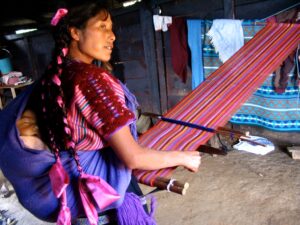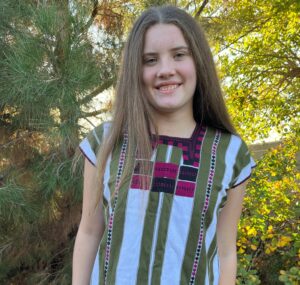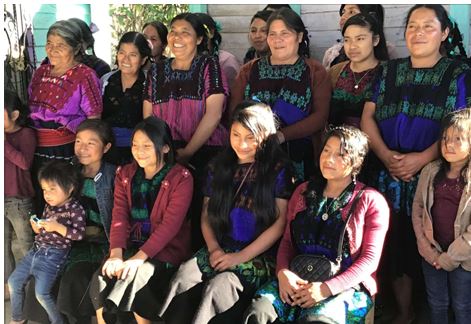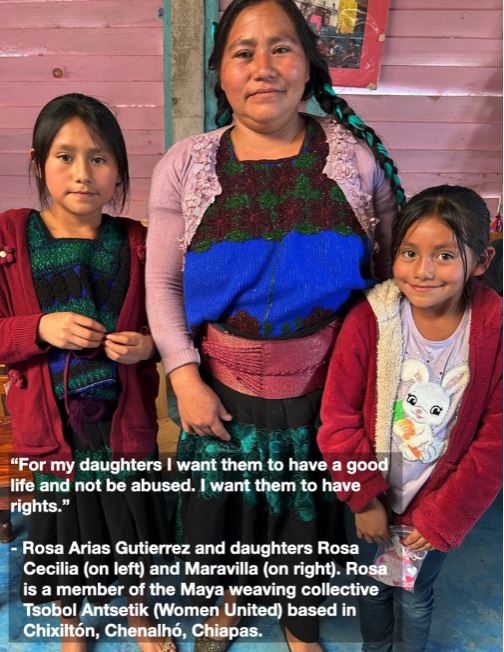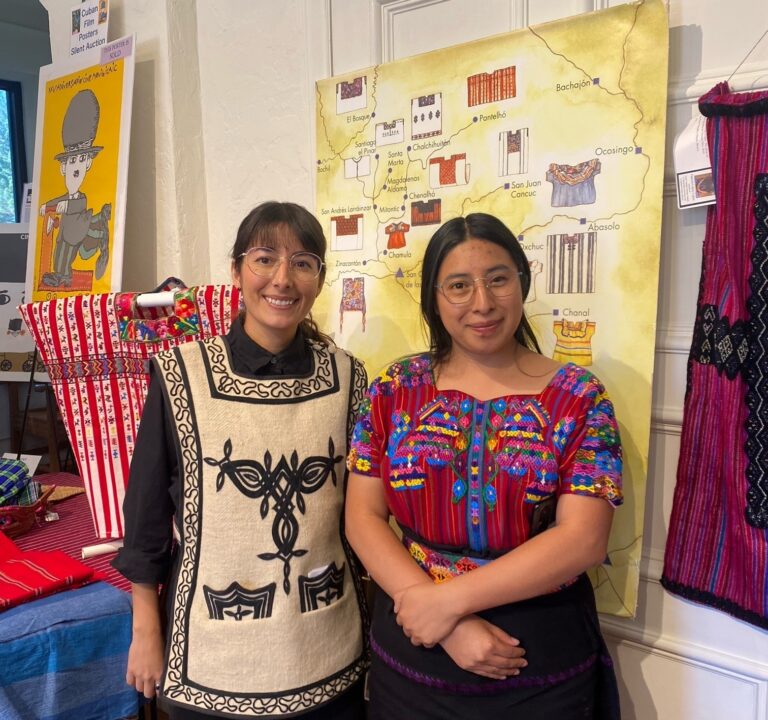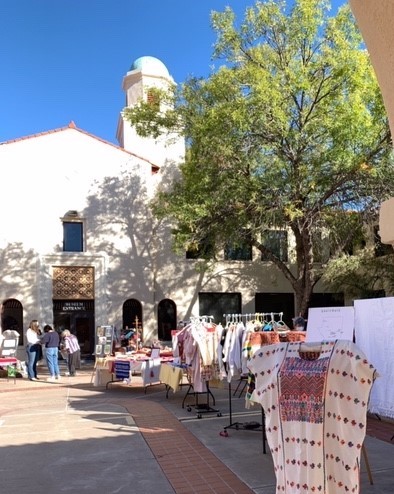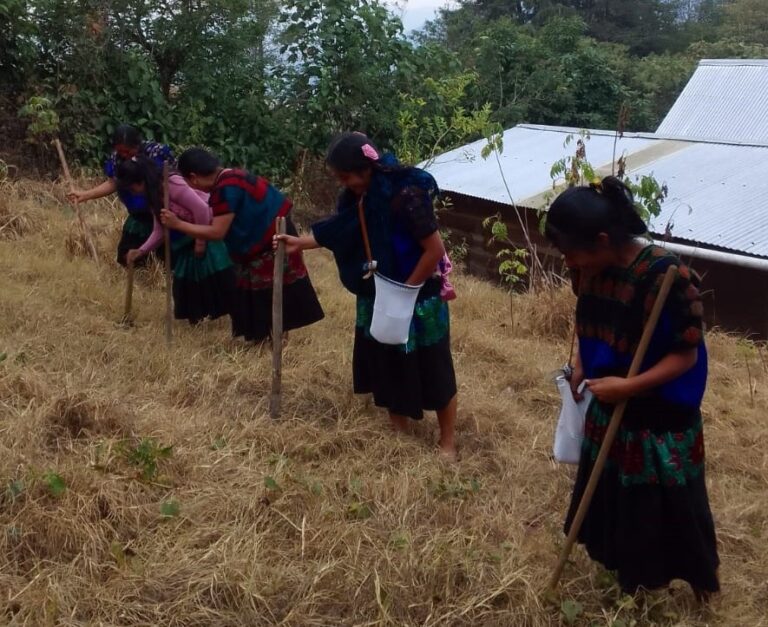Each hand woven textile is truly a work of art. As you look at the weavings, you will notice that some designs have strong images – resembling animals, people and more. Weaving is a traditional activity, and every item carries strong cultural symbolism. Here are a few of the symbols and their significance.

COSMOGRAM/COSMOGRAMA /TRUE DESIGN/VERDEDERO DISENO)/BATS’I LUCH AND GRAND DESIGN/GRAN DISEÑO/ MUK TA LUCH A rhomboid design is one of the most important and ubiquitous designs on textiles in highland Chiapas. It is a direct descendent of a design woven into the garment Lady Xoc of Yaxchilán wore in 709 C.E. It depicts the Maya cosmos, a quartered universe moving through time, uniting Earth and Sky. It also charts the path of Sun, a principal diety, from east (symbolized by the top diamond) to west (symbolized y the bottom diamond.) Weavers represent the Sun in motion by repeating row after row of diamonds.
The recovery of this design began in the 1930s when weavers from Tenejapa went to Chenalhó to learn how to brocade. They adapted the cosmogram in Chenalhó called muk ta luch to create what they dubbed the dog’s pawprint. Eventually Chenalhó weavers took this design back but refer to it as bats’i luch (true design)
Un diseño romboidal es uno de los diseños más importantes y ubicuos en textiles en los altos de Chiapas. Es un descendiente directo de un diseño tejido en el huipil que llevaba Lady Xok de Yaxchilán en 709 d.C. Representa el cosmos maya, un universo en cuartos que se mueve a través del tiempo, uniendo la Tierra y el Cielo. También traza la trayectoria del Sol, una deidad principal, desde el este (simbolizado por el diamante superior) hasta el oeste (simbolizado por el diamante inferior). Los tejedores representan al Sol en movimiento por medio de repetir fila tras fila de diamantes.
La recuperación de este diseño se inició en la década de 1930 cuando tejedoras de Tenejapa se viajaron a Chenalhó para aprender a hacer brocados. Adaptaron el cosmograma en Chenalhó llamado muk ta luch para crear lo que llamaron la huella del perro. Finalmente, los tejedores de Chenalhó recuperaron este diseño, pero se refieren a él como bats’i luch (diseño verdadero).

WOMAN/MUJER/ANTS
Gender complementarity remains an important ideal in Tsotsil-Maya communities. The principle is symbolized by designs representing men and women. The woman symbol has three fingers and toes and three lines descending from her vagina connecting her to Earth which is often referred to as “Our Mother.” Three is the ancient Maya number for women, representing the three stones that hold up the comal, the clay griddle on which women make tortillas. Still today, women complement their kinsmen’s work in cornfields by transforming corn into food for their families.
La complementariedad de género sigue siendo un ideal importante en las comunidades tsotsil-mayas. El principio está simbolizado por diseños que representan a hombres y mujeres. El símbolo de la mujer tiene tres dedos de manos y pies y tres líneas que descendían de su vagina, conectándola a la tierra que a menudo se conoce como “Nuestra Madre.” Tres es el antiguo número maya para mujeres, que representa las tres piedras que sostienen el comal, la plancha de barro sobre la que las mujeres hacen tortillas. Aún hoy, las mujeres complementan el trabajo de sus esposos y otros parientes en los campos de maíz transformando el maíz en alimento para sus familias.

MAN/HOMBRE/VINIK
Gender complementarity remains an important ideal in Tsotsil-Maya communities. The principle is symbolized by designs representing men and women. The man symbol has four fingers and toes symbolizing the four corners of the milpa, the corn and bean field, where men carry out their principle responsibilities to their families – to grow the food they eat.
La complementariedad de género sigue siendo un ideal importante en las comunidades tsotsil-mayas. El principio está simbolizado por diseños que representan a hombres y mujeres. El símbolo de un hombre tiene cuatro dedos de manos y pies que simbolizaba los cuatros lados de la milpa, el campo de maíz y frijol, donde los hombres llevan a cabo sus responsibilidades principales para sus familias – cultivar los alimentos que comen.
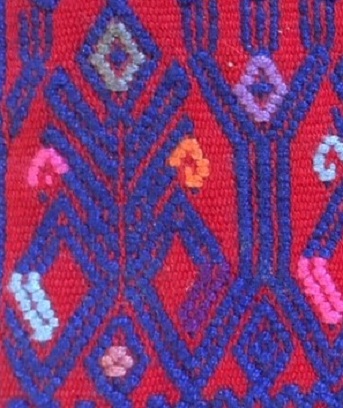
ANCESTORS/ANTEPASADOS/TOTIL ME’IL/STOT SME’ The ancestors include the recently and long-ago departed who often merge with sky gods, saints and stars. The ancestors are guides in respectful human comportment. They inhabit caves and there in corrals keep the animal spirit companions of humans safe. They only release an animal companion when its mortal counterpart commits an offense against society. Three crosses sit atop holy hills serving as portals to the inner sanctum of the ancestral gods.
Los antepasados incluyen a los difuntos hace mucho tiempo que a menudo se fusionan con los dioses del cielo, los santos y las estrellas. Los antepasados son guías en el comportamiento humano respetuoso. Habitan en cuevas y allí, en corrales, mantienen a salvo a los compañeros espirituales animales de los humanos. Solo liberan a un animal de compañía cuando su contraparte mortal comete una ofensa contra la sociedad. Tres cruces se asientan sobre cerros sagrados que sirven como portales al santuario interior de los dioses ancestrales.

BEE/ABEJA/CHANUL POM This symbol is inspired by Civil Society the Bees, an organization of Catholic families that formed in Chenalhó in 1992. Since the Zapatista uprising in 1994, the Bees have worked in solidarity with the Zapatistas to overcome social injustices through non-violent means. A tragic consequence of this group’s solidarity with the Zapatistas was the massacre by a paramilitary group on December 22, 1997 of 45 members of Abejas who were praying for peace in a chapel in Acteal, Chenalhó. Since then, children and mothers have been embroidering bees on various textiles, like book marks, with the name for bee in Spanish and Tsotsil.
Este símbolo está inspirado en Sociedad Civil las Abejas, una organización de familias católicas que se formó en Chenalhó en 1992. Desde el levantamiento zapatista de 1994, las Abejas han trabajado en solidaridad con los zapatistas para superar las injusticias sociales por medios pacificos. Una trágica consecuencia de la solidaridad de este grupo con los zapatistas fue la masacre por parte de un grupo paramilitar el 22 de diciembre de 1997 de 45 miembros de Abejas que rezaban por la paz en una capilla de Acteal, Chenalhó. Desde entonces, niños y madres bordan abejas en varios tejidos, como bolsitas de hilo, con el nombre de abeja en español y tsotsil.

PINE NEEDLES/TOJ and BROMELIADS/BROMELIAS/Ech are only used to decorate holy places, spaces, and objects – churches, saints, crosses, and the ground beneath altars for Day of the Dead/Día de los Muertos/sk’in ch’ulelal. These symbols appear around the neck of ceremonial huipils. Pine needles are represented by a chevron design.
Junciay bromelias solo se usan para decorar lugares, espacios y objetos sagrados: iglesias, santos, cruces y el suelo debajo de los altares para el Día de Muertos / sk’in ch’ulelal. Estos símbolos aparecen alrededor del cuello de los huipiles ceremoniales. Las agujas de pino (juncia en Chiapas) están representadas por un diseño de chevron.

PATH OF SNAKE/CAMINO DEL SERPIENTE/BE CHON
The path of the snake often symbolizes a road, a metaphor for royal office. When the Maya dieties created the universe they placed three stones in the constellation of Orion to form the cosmic hearth that created Earth. The serpent was one of the three stones. Serpents are often associated with the fertility of Earth and bestower of good fortune, as well as of underworld entrapment by Pukuj, the devil.
El camino de la serpiente a menudo simboliza un camino, una metáfora del cargo real. Cuando las deidades mayas crearon el universo, colocaron tres piedras en la constelación de Orión para formar el hogar cósmico que creó la Tierra. La serpiente fue una de las tres piedras. Las serpientes a menudo se asocian con la fertilidad de la Tierra y otorgan buena fortuna, así como con la trampa del inframundo por Pukuj, el diablo.

GOLDEN OLIVE WOODPECKER/Colaptes rubiginosus /TI’ is the Tsotsil name for the Golden Olive Woodpecker. In Maya bird lore, this bird was one of God’s bird messengers. The Ti’s role was to wait in heaven for God – or one of the senior bird messengers – to send him or her down to earth to warn people that Pukuj, the devil, was going to bring harm to them. To this day, Maya elders pay close attention to birds in case their songs bring an important message. Only with prompt prayers can harm be averted. Traditional huipils from Venustiano Carranza are adorned with a row of Ti’ on the hem, protecting both the weaver and the wearer.
En el saber mayas de aves, este pájaro era uno de los mensajeros de Dios. El papel del Ti era esperar en el cielo a que Dios, o uno de los mensajeros de aves mayores, lo enviara a la tierra para advertir a la gente que Pukuj, el diablo, les haría daño. Hasta el día de hoy, los ancianos mayas prestan mucha atención a los pájaros en caso de que sus canciones traigan un mensaje importante. Solo con oraciones inmediatas se puede evitar el daño. Los huipiles tradicionales de Venustiano Carranza están adornados con una hilera de Ti ’en el dobladillo, protegiendo tanto la artesana como al usuario.

ZAPATISTA WOMAN IN A FLOWER/MUJER ZAPATISTA EN UNA FLOR/ANTS ZAPATISTA LI OY TA NICHIM This embroidered design represents the centrality of women’s rights to the Zapatista movement and its potential to lead to a greater flowering of and respect for the original peoples of Chiapas and the world. The woman is shown with a face masks. Zapatistas say that they cover their faces to focus on their collective identities and to show, ironically, that until they organized to defend their rights they were invisible to those in power. Embroidery has become an important technique in recent decades in Chiapas with the growth of cooperatives that seek to find ways to make money for women who may not know how to weave.
Este diseño bordado representa la centralidad de los derechos de las mujeres en el movimiento zapatista y su potencial para conducir a un mayor florecimiento y respeto por los pueblos originarios de Chiapas y el mundo. La mujer se muestra con una máscara facial. Los zapatistas dicen que se cubren la cara para enfocarse en sus identidades colectivas y para mostrar, irónicamente, que hasta que se organizaron para defender sus derechos eran invisibles para quienes estaban en el poder. El bordado se ha convertido en una técnica importante en las últimas décadas en Chiapas con el crecimiento de cooperativas que buscan encontrar formas de ganar dinero para mujeres que quizás no sepan tejer.

THE PLUMED SERPENT/SERPIENTE PLUMADA/QUETZALCOATL/ K’UK’ULCHON
The plumed serpent graces textiles as the double-headed feathered serpent. For Mayas, this animal represents a fertile earth. The symbol also stands for the planet Venus as it moves through the heavens. The two-headed serpent reflects the difficult discovery made by ancient Maya astronomers that Venus blazes forth as both the morning star and the evening star.
La serpiente emplumada adorna los tejidos como serpiente emplumada de dos cabezas. Para los mayas, este animal representa una tierra fértil. El símbolo también representa al planeta Venus mientras se mueve por los cielos. La serpiente de dos cabezas refleja el difícil descubrimiento hecho por los antiguos astrónomos mayas de que Venus resplandece como la estrella de la mañana y la estrella de la tarde.

SUN/SOL/TOTIK/JESUS/JESÚS/OUR FATHER/NUESTRO PADRE/TOTIK
To Tsotsil Mayas Sun is Our Father and Jesus Christ. In rituals they pray before his flowery face. In myths flowers cover his road. In ceremonies his symbol looms as the flowery flag below.
Para tsotsil mayas, el Sol es Nuestro Padre y Jesucristo. En los rituales rezan ante su rostro florido. En los mitos las flores cubren su camino. En las ceremonias, su símbolo asoma como la bandera florida de abajo.
The following websites created by Mexicolore, a teaching team based in London, provide the meanings of additional Maya textile symbols: https://www.mexicolore.co.uk/maya/teachers/resource-20-traditional-maya-textile-symbols and https://www.mexicolore.co.uk/maya/teachers/recurso-20-simbolos-tradicionales-maya

